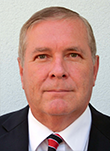 |
|
||||
BiographySiegfried Selberherr was born in Klosterneuburg, Austria, in 1955. He received the degree of Diplomingenieur in electrical engineering and the doctoral degree in technical sciences from the Technische Universität Wien in 1978 and 1981, respectively. Prof. Selberherr has been holding the venia docendi on Computer-Aided Design since 1984. From 1988 to 1999 he was the Head of the Institute for Microelectronics. From 1998 to 2005 he served as Dean of the Faculty of Electrical Engineering and Information Technology. His current research topics are modeling and simulation of problems for microelectronics engineering. |
|||||
Preface
Welcome to the 32nd annual research review of the Institute for Microelectronics! Our permanent staff members, financed by the Austrian Federal Ministry of Education, Science and Research, have changed from last year and consist of eight full-time and four part-time employees. These include, five professors, one assistant professor, two senior scientists, a secretary and one part-time and two full-time technical assistants. In addition, one federally funded post-doctoral researcher and five doctoral researchers are working on exciting research problems. A further nineteen scientists and eight post-doctoral researchers are presently funded through projects supported by our industrial partners, the Austrian Science Fund (FWF), the Austrian Research Promotion Agency (FFG) and the Christian Doppler Gesellschaft (CDG).
Over the last year, three direct industrially funded projects, one by the Federal Ministry Republic of Austria (“Modeling of Radiation Effects in Flash Memories”), one by Associations, Foundations, Awards (“Efficient Quantum Transport Model for TCAD Applications”) and one by the Austrian Science Fund (“Single-Trap Characterization Methodology for Nanoscale MOSFETs”), have been successfully completed. The CDG projects on “High performance Technology CAD” and “Nonvolatile Magnetoresistive Memory and Logic”, as well as three projects funded by the FWF and the three FFG projects, “Innovative Communication Electronics for Aircraft Engines”, “Innovative Networks for networked Aircraft Subsystems” and “Technology Computer Aided Design of Negative Capacitance and Ferro-Electric Transistors”, are proceeding according to plan.
We are very pleased that our industrial partners have continued and extended their support for projects covering a wide range of topics, including reliability at cryogenic temperatures, the potential and risks of pilot technologies in regards to reliability, manufacturing and application of power semiconductors, efficient quantum transport modeling for TCAD applications, advanced MOSFET reliability characterization using array structures, modeling of hot-carrier degradation in Si-transistors and quantum mechanical simulation of tandem solar cells to study the influence of technological parameters on efficiency.
It is a great pleasure for us to report that three directly funded projects, namely “Reliability at cryogenic temperatures”, “Quantum Mechanical Calculation of Electronic Parameters” and “Highly efficient characterization of transistor arrays”, three FWF projects, “Ultimate Scaling and Performance Potential of MoS2 FETs”, “Numerical Constraints for the Wigner and the Sigma Equation” and “General Nano-Electromagnetic Quantum Phase Space Model” as well as one H2020 project, “Modeling Unconventional Nanoscaled Device FABrication” and one Christian Doppler Laboratory, “Single-Defect Spectroscopy in Semiconductor Devices”, have been started during the past year.
We are exceptionally proud of our Institute's continuously high academic and scientific output. This is reflected in our large number of long-term projects and in our high number of publications, especially when it comes to contributing to and participating in international conferences. We are aware, however, that this success would not be possible without the continuous support of our collaborators within academia and industry. We would therefore like to explicitly express our gratitude for their trust in our scientific work. In this regard, we are entering into the next year of our Institute, as ever, with high expectations.


